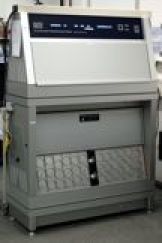Accelerated weathering devices

Accelerated weathering devices (Q-Lab)
Sunlight and moisture (rain and dew) can cause damage to technical textiles and foils over the years. Depending on the type of material, e.g. softeners migrate, which makes coatings porous and brittle, moisture penetrates the fabric and "corrodes" the fibres, colours change or the material loses its shine. An essential result of the weather influence over many years is the reduction of the tear resistance of the membrane materials.
A accelerated weathering chamber simulates the aging of technical textiles and foils in accelerated form by UV irradiation, condensation and spraying with water.
Changes in the material, starting from the new material, can be simulated, estimated and metrologically evaluated over time.
Radiant intensity is constantly monitored and recorded and fluctuations caused by lamp wear are compensated by regulating the power supply. Thus wavelength and light intensity remain constant.
We have 2 accelerated weathering chambers, each with 24 samples in the size of monoaxial strip tensile samples, weatherable area each approx. 65 mm x 200 mm. In addition, single large specimens with dimensions of up to 490 mm x 300 mm are possible.
Technical data:
- Irradiation by UVA-340 lamps
- Irradiance up to 0.68 W/m² at 340 nm with excellent simulation of the sunlight spectrum in the UV range (corresponds to about 1000 W/m2 global solar radiation)
- Temperatures from 45°C to 80°C possible
- Condensation at 8 litres per day and spraying at 7 litres per minute
A VE device from IEM is installed for water treatment:
- Ultrapure water reverse osmosis EDI (electrodeionisation) water treatment system
- Capacity 10 litres / hour
- Product conductivity < 1 μS/cm (without consideration of CO2)
- Pressure tank stainless steel 50 litres, horizontal (total volume 50 litres of which approx. 30 litres of water)
Weathering cycles according to normative specifications, e.g. DIN EN ISO 4892-3, DIN EN 15619 or DIN EN 12224, are just as possible as individually designed cycles.
